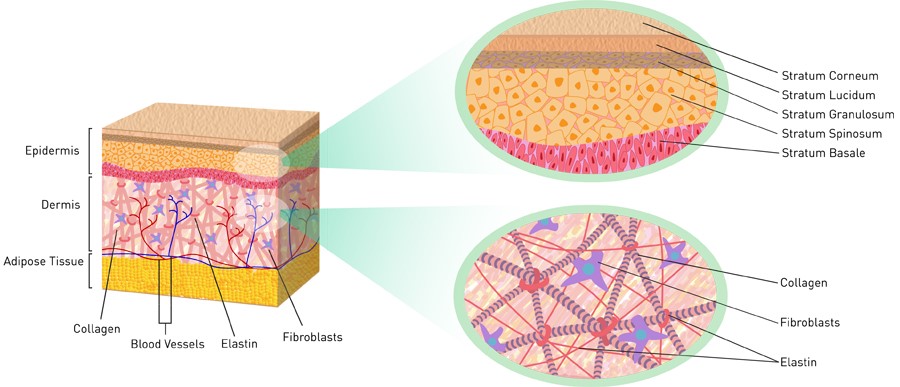In the natural process of aging, skin begins to wrinkle, thin, and facial features become more severe. As we age, degenerative processes affect our skin and the deep structures beneath. Intrinsic aging of human skin, leading to wrinkles and loss of elasticity, is a result of the passage of time not due to exposure to sunlight or toxins6. Skin can be understood in terms of distinct layers whose structures dictate their function. The avascular epidermis, the most superficial layer, is made up of five layers of constantly differentiating cells which form a barrier to protect the body from the environment 6. Deep to the epidermis is the dermis, which is composed of few cells, many blood vessels, and structural proteins such as collagen and elastin that interweave to form a web of structural fibers6.During the aging process molecular events alter how these cells and the protein products made by them are able to function and ultimately change the appearance of the skin. The structural changes seen in intrinsic aging skin are not only due to changes in the skin cells of the epidermis, but also due to changes in the dermal collagen and elastin matrix below.

The aging process involves the degradation of important structural components of the skin including extracellular matrix fibers such as elastin and collagen. When these structures fall apart the deep layer of the skin, the dermis, is unable to retain water4. Furthermore the proportion of cell types within the skin changes as we age so there is a reduction in the amount of fibroblasts, and a disorganization of the elastic fibers which leads to a loss of elasticity of the skin as well as tone4. Finally the deep layers of the skin atrophy which leads to a sinking and increased angularity of the face4.
The epidermal layer of the skin is very efficient at protecting the body from pathogens and the environment. Although, this means that creams are inefficient when trying to reduce wrinkles by reinforcing the dermal layer with large proteins like collagen2. In order to rejuvenate aging skin and improve volume and contour, plastic surgeons have used fat grafting techniques and adipose (fat) derived stem cells with great results 5,7,8. Generally, the surgeon will remove fat from the patient’s abdomen or thighs and inject it in the dermis3. The results from this procedure can last from a few months to years, but on the other hand it can also lead to donor site morbidity and pain3.

Luiz Charles-de-Sa, MD and colleagues published a paper hoping to uncover the elusive mechanism by which fat grafting is able to have clinically visible long term improvement. Was it the stem cells, or other components of the adipose tissue that are responsible for the results seen in the clinic? Researchers took skin samples from patients before their procedure, and three months after they were treated with fat grafting supplemented with stromal vascular fraction or adipose derived stem cells. Researchers found that both conditions induced similar results. Before treatment there were a large number of elastic fibers deep in the dermis. After both treatments there is a reorganization of the dermis and the proliferation of new fibers. The question of mechanism still remains, but it is clear that fat with stromal vascular fraction or expanded mesenchymal stem cells can modify the organization of fibers in the dermis which will have the desired rejuvenating transformation of the face.
The aging process and this fat grafting intervention demonstrate the concept of structure and function. During aging there is a disorganization of the structures below the superficial dermis creating a new landscape for the skin. As the face hollows and the tone of the skin decreases, the features of the face become more angular and wrinkles form. In order to rejuvenate the face, a plastic surgeon fills in the spaces that have become hollow. The introduction of fat or stem cells directs the disorganized and hollow extracellular matrix to realign increase in density and regain previous functions8. In doing so the texture and the elasticity of the skin are improved and the face looks younger and revived.
1..Bonta, M., Daina, L., & Muţiu, G. (2012). The process of ageing reflected by histological changes in the skin. Romanian journal of morphology and embryology= Revue roumaine de morphologie et embryologie, 54(3 Suppl), 797-804.
2..Bos, J. D., & Meinardi, M. M. (2000). The 500 Dalton rule for the skin penetration of chemical compounds and drugs. Experimental dermatology, 9(3), 165-169.
3..Buck, D. W., Alam, M., & Kim, J. Y. (2009). Injectable fillers for facial rejuvenation: a review. Journal of Plastic, Reconstructive & Aesthetic Surgery, 62(1), 11-18.
4..Charles-de-Sá, L., Gontijo-de-Amorim, N. F., Takiya, C. M., Borojevic, R., Benati, D., Bernardi, P., … & Rigotti, G. (2015). Antiaging treatment of the facial skin by fat graft and adipose-derived stem cells. Plastic and reconstructive surgery, 135(4), 999-1009.
5..Del Vecchio, D., & Rohrich, R. J. (2012). A classification of clinical fat grafting: different problems, different solutions. Plastic and reconstructive surgery, 130(3), 511-522.
6..Naylor, E. C., Watson, R. E., & Sherratt, M. J. (2011). Molecular aspects of skin ageing. Maturitas, 69(3), 249-256.
7..Meruane, M. A., Rojas, M., & Marcelain, K. (2012). The use of adipose tissue–derived stem cells within a dermal substitute improves skin regeneration by increasing neoangiogenesis and collagen synthesis. Plastic and Reconstructive Surgery, 130(1), 53-63.
8..Mojallal, A., Lequeux, C., Shipkov, C., Breton, P., Foyatier, J. L., Braye, F., & Damour, O. (2009). Improvement of skin quality after fat grafting: clinical observation and an animal study. Plastic and reconstructive surgery, 124(3), 765-774.
9..“The Science Behind Pure GOLD COLLAGEN.” Pure Gold Collagen Anti-Ageing Research and Science http://world.gold-collagen.com/wp-content/uploads/2014/01/SKIN-ILLUSTRATION-FINAL-VERSION.jpg Date accessed: 10/11/2016
